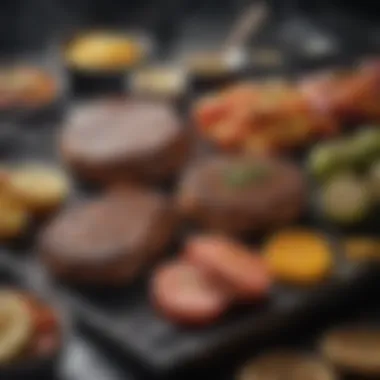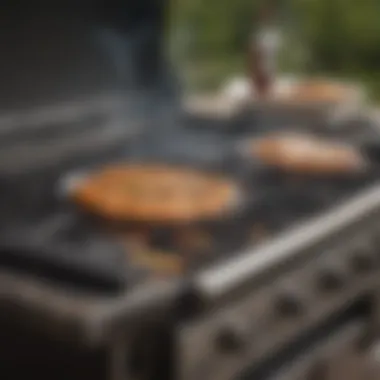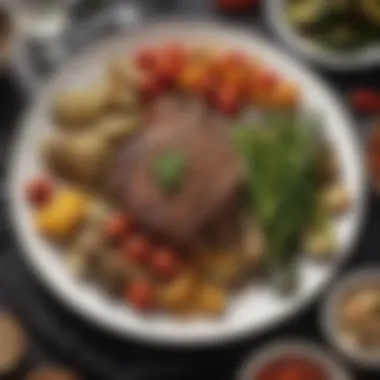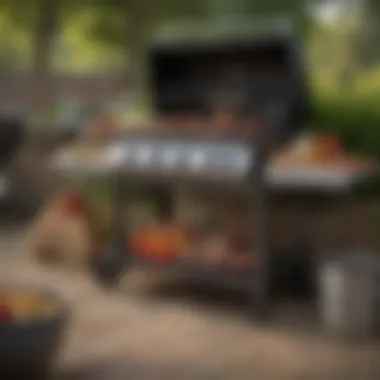Mastering the Grill: Unlocking Side Burner Techniques


Intro
Grilling is not just about cooking; it's an art that requires skill and a good understanding of the tools at hand. One such tool that can enhance your grilling experience is the side burner. Many people overlook this feature, assuming it is merely an attachment. However, when used effectively, the side burner can greatly improve your ability to prepare various dishes simultaneously, offering efficiency and versatility to your culinary endeavors.
In this guide, we will delve deep into the functionalities of side burners, detailing their advantages and the types of dishes you can effortlessly create with them. This will not only simplify your cooking but also enhance your grilling experience. The article includes maintenance tips to ensure longevity, safety precautions to keep in mind, and effective techniques that will aid in mastering the grill. With busy lifestyles, many individuals seek ways to improve their cooking routines. Therefore, understanding how to integrate a side burner into your grilling methods may provide the culinary outcome you desire.
Preface to Grill Side Burners
Grill side burners are often overlooked yet they play a critical role in enhancing the grilling experience. The incorporation of a side burner can expand culinary possibilities beyond traditional grilling. With a side burner, cooks can prepare sauces, side dishes, and even other proteins simultaneously. This article aims to explore various aspects of side burners, emphasizing their functionality, benefits, and the foods that can be prepared.
Definition and Functionality
A side burner is an additional cooking surface attached to a grill. It allows for diverse cooking methods, making it easier to create full meals in one place. The primary function is to provide an extra heat source that can operate independently from the main grill. This feature enables cooks to boil, sauté, or simmer various dishes without needing a separate kitchen stove. This significantly elevates the outdoor cooking advantages, enabling a more versatile grilling setup.
Types of Side Burners
A better understanding of the different types of side burners can help you choose the one that best fits your grilling style. Here are the main types:
Single Burner
A single burner is often the simplest form of a side burner. It typically features one cooking zone and is ideal for tasks like simmering sauces or boiling vegetables. This straightforward design makes it an accessible option for those new to grilling. The key characteristic of a single burner is its compact size, which allows for easy integration with most grill setups. While it offers limited cooking capacity, it presents a beneficial choice for those who prioritize efficiency and simplicity in their outdoor cooking.
Double Burner
The double burner variant provides the advantage of two independent cooking zones. This flexibility allows cooks to heat multiple items simultaneously, like preparing two different sauces or cooking a protein while warming a side dish. The key characteristic here is enhanced versatility, making it a popular choice for those who enjoy hosting gatherings. However, the additional space it occupies is a consideration, as it may not fit in smaller grill setups. The ability to manage various dishes concurrently makes it an attractive option for culinary enthusiasts looking to maximize their cooking efficiency.
Power Burner
Power burners are designed for high-heat cooking, allowing temperatures that may exceed those in typical side burners. This type is perfect for achieving a good sear on meats or boiling water quickly. The main appeal of a power burner lies in its output, as it can produce significant heat necessary for more demanding cooking tasks. However, this intensity can also lead to overcooking if not supervised closely. The choice of a power burner can open the door to different cooking techniques, though it requires more careful management compared to its counterparts.
Advantages of Grilling with a Side Burner
Grilling with a side burner is not just a luxury; it fundamentally transforms the way culinary enthusiasts approach outdoor cooking. The importance of this section is rooted in the unique advantages that side burners present, which enhance one’s grilling experience in various dimensions. Leveraging side burners allows for efficiency, flexibility, and even creativity in the kitchen, offering a seamless transition between grilling and stovetop cooking. The various benefits of utilizing a side burner are integral to optimizing your culinary routines.
Enhanced Cooking Flexibility
Enhanced cooking flexibility is perhaps the most significant advantage of a side burner. With a side burner, cooks can easily prepare additional components of a meal all at once. For instance, while grilling burgers or steaks, sauces can simmer away on the side burner without interrupting the main grilling process. Furthermore, this method allows for the incorporation of diverse cooking techniques. One can saute garlic and onions alongside searing vegetables, further adding layers to a dish.
Additionally, a side burner reduces meal prep time. For those who value efficiency, being able to execute multiple cooking tasks simultaneously means that family dinners or entertaining guests can be managed more effectively. In essence, the side burner turns a simple barbecue into a full cooking experience, encouraging cooks to think beyond the grill.
Simultaneous Cooking Opportunities
Simultaneous cooking opportunities significantly enhance a griller's capability. The side burner enables the preparation of side dishes while the primary grilling occurs uninterrupted. Imagine the efficiency of boiling corn or preparing a pasta dish right next to your primary grilling zone.
This dual capability minimizes the workload in the kitchen and allows you to maximize the grill’s potential. Moreover, it fosters creativity in menu planning. You can prepare several items at once, making it easier to cater to various taste preferences, from grilled meats to vegetarian sides.
"A side burner offers unparalleled advantages by seamlessly integrating stovetop cooking with grilling, allowing the culinary enthusiast to maximize their time and efforts."
In summary, the advantages of grilling with a side burner cannot be overstated. Enhanced cooking flexibility and simultaneous cooking opportunities streamline the culinary process, enabling more complex and enjoyable meal preparations.
Popular Foods to Cook on a Side Burner


Cooking on a side burner opens up a realm of possibilities beyond simple grilling. This section will detail the types of foods that can be effectively prepared on a side burner, emphasizing their importance in enhancing meals prepared on the main grill. Understanding these options can lead to a more diverse and satisfying culinary experience.
Sauces and Marinades
One of the notable advantages of a side burner is the ability to prepare sauces and marinades simultaneously while grilling main dishes. These elements can greatly enhance the overall flavor profile of grilled foods.
When making marinades, it is helpful to use fresh ingredients. Ingredients like garlic, herbs, and citrus can be blended together in a pot and gently simmered. This technique allows the flavors to meld together, creating a truly rich marinade or sauce that complements grilled meats or vegetables. A common mistake is rushing this process; patience can result in a depth of flavor that transforms ordinary dishes.
Having the sauce ready alongside the grill means it can be applied right after cooking. This timing ensures that meats stay moist and flavorful. Simmering sauces on the burner also allows for easy adjustments in seasoning, ensuring that each batch is perfect.
Vegetable Sides
Side burners are ideal for cooking vegetables that can accompany grilled meats. Sautéing vegetables in oil or butter allows them to caramelize, adding a delightful sweetness. Vegetables such as bell peppers, onions, and zucchini can be quickly cooked in a pan on a side burner, which is convenient when the main grill is already occupied.
Moreover, cooking vegetables separately helps avoid overcrowding the main grill. Overcrowding can lead to uneven cooking and reduced temperature. On the side burner, vegetables can receive attention; they can be adjusted for texture and flavor, ensuring they remain vibrant and tasty.
Using pots or pans to grill side vegetables is straightforward. Seasoning them with herbs and spices while they cook makes certain that their flavors shine. This technique promotes the use of fresh produce, which can be a healthy enhancement to grilled meals.
Starches: Rice and Grains
Another great use of the side burner is cooking starches like rice, quinoa, or pasta. These can serve as a filling base for larger meals. The convenience of doing this on the side allows the main grill to focus on proteins, while grains or starches cook to perfection on their own.
For instance, preparing a tasty rice pilaf alongside grilled chicken is easily achieved. Simply add water, rice, and desired spices to a pot and let it simmer. This method simplifies the cooking process and keeps everything organized.
Maintaining proper ratios of water to rice is essential for achieving the right texture. Monitoring it on the side burner ensures that there is no overcooking due to distractions caused by main grilling tasks. This results in well-rounded meals that are both comforting and satisfying.
These kinds of side dishes not just complement grilled items but also help balance meals, making them more nutritious overall.
In summary, the versatility of a side burner allows culinary enthusiasts to explore a variety of tastes and textures, from rich sauces to crisp vegetable sides and satisfying starches. Each of these options not only enhances the meal but also enriches the grilling experience.
Setting Up Your Grill with a Side Burner
Setting up your grill with a side burner is essential to making the most out of your culinary endeavors. A proper setup allows for efficient cooking and enhances the overall grilling experience. This section discusses several key elements you should consider when preparing your grill.
Preparation for Use
Before using a side burner, it is crucial to ensure that everything is in an optimal state. Start by inspecting the burner and its connections. Check for any gas leaks by applying a soapy water solution to the hoses. If bubbles form, this indicates a leak that needs addressing.
Another important step is to clean the side burner area. Ensure it is free of debris or burnt food from previous uses, as these remnants can affect the flavor of your dishes and may create hazards. Once cleared, ensure that the side burner is properly positioned and stable. This will prevent accidents and spills while cooking, essential for creating a safe environment.
"A well-prepared burner significantly reduces the risk of accidents during the cooking process."
The final preparation step involves gathering your cooking tools and ingredients. Place necessary utensils close to the burner to facilitate smooth cooking. This includes pots, pans, and spices required for your dishes.
Optimal Temperature Settings
Setting the right temperature on your side burner is critical for achieving the desired cooking results. Cooking too hot can burn your sauces or overcook vegetables, while cooking too low can lead to uneven results. It is recommended to use burners with an adjustable flame.
When starting, preheat the side burner for a few minutes. The flame should be set low initially for gentle heating. This is particularly important for sauces and marinades that require simmering.
For sautéing vegetables or brown meat, a medium to high flame is suitable. Always monitor the food's progress and adjust the temperature as needed for further cooking phases. This careful temperature management allows for better control of cooking times and improved flavor retention in your dishes.
By following these guidelines, you can create a well-organized and effective cooking environment that maximizes the use of your side burner.


Cooking Techniques for Side Burners
Using a side burner effectively can greatly enhance your grilling repertoire. This section will detail the cooking techniques appropriate for side burners, providing insights into how to maximize their potential for both flavor and efficiency.
Side burners facilitate diverse cooking methods, allowing for straightforward meal preparations. The two primary methods tackled here are direct heating and indirect cooking. Each has its unique advantages and situations where it shines best. Knowing when and how to deploy these techniques can lead to superior outcomes and more enjoyable grilling sessions.
Direct Heating Methods
Direct heating, often referred to as high-heat cooking, is about placing food directly over a flame. This technique is valuable for several reasons. It provides quick searing, locking in moisture and flavor in meats. Ideal for steaks, fish, and certain vegetables like bell peppers, direct heating ensures an appealing texture and an excellent caramelization.
- Searing and Browning: Direct heat is essential for achieving that signature crust on steaks. A high temperature sears the outside while keeping the inside juicy. This is particularly effective on cuts like ribeye or tenderloin.
- Quick Cooking Time: Foods that need to cook quickly benefit from direct heating. This is fundamental in scenarios where timing is crucial, like preparing dinner for guests who arrive at a certain time.
- Grilled Vegetables: Direct heat brings out the sweetness in vegetables like zucchini and asparagus. A few minutes over the fire can transform their flavor profile dramatically.
To utilize direct heat effectively, preheat the side burner before placing food on it. This step is vital to ensure even cooking. Consider placement carefully, as proximity to the flame will influence cooking time.
Indirect Cooking Methods
Indirect cooking involves placing food away from the direct flame, utilizing the ambient heat for a more gentle cooking process. This method excels in situations where longer cooking times are necessary or when cooking larger cuts of meat.
- Slow Cooking: Indirect heat allows for slow-cooked dishes that can develop deeper flavors. Think of barbecuing ribs or briskets, where cooking them slowly results in tender, flavorsome meals.
- Braising and Sauces: The side burner is also perfect for simmering sauces or braising vegetables while the main grill handles the protein. A well-prepared sauce can elevate a simple grilled dish.
- Consideration of Heat Sources: Utilizing the indirect method can also help prevent flare-ups, making it safer when working with fatty meats.
When applying indirect heat, set up your side burner so that the temperature remains consistent throughout the cooking process. Monitor closely to ensure even cooking, checking for doneness as cooking times may vary widely.
Important Note: Always be prepared to adjust your technique based on the specific food you are preparing and the characteristics of your grill.
Cleaning and Maintenance of Side Burners
Cleaning and maintenance of side burners are crucial for both safety and performance. Just like the main grill, a side burner requires regular attention to ensure that it operates correctly and safely. Neglecting maintenance can lead to inefficient function or even dangerous situations. This section will explore the key considerations for maintaining a side burner, emphasizing the specific benefits and practices involved.
Maintaining your side burner offers several advantages. First, it helps in preserving the longevity of the appliance. Accumulated grease and debris can cause malfunctioning parts and potentially expensive repairs. Second, regular cleaning can enhance the flavor of the food cooked, as residues can alter taste. Third, routine check-ups set you on a safer path. It ensures gas connections and ignition systems are functioning well, significantly reducing hazards in your cooking area.
Regular Cleaning Frequency
The frequency of cleaning your side burner largely depends on usage. For regular users, cleaning is recommended after every use. This may seem exhaustive; however, it reduces the buildup of grease and enhances the burner’s efficiency.
Here are some guidelines for cleaning frequency:
- After Every Use: Wipe down burners, grates, and surrounding areas post-cooking.
- Weekly: Conduct a more thorough cleaning. This includes scrubbing removable parts and clearing any dirt or residues.
- Monthly: Inspect the appliance for any wear or tear, ensuring that all parts are clean and functioning properly.
- Seasonally: Perform a deep clean before the grilling season starts or after to maintain optimal performance.
Tools and Products Recommended
Several tools and cleaning products will aid in maintaining your side burner effectively. The right equipment can simplify the process and make it more efficient:
- Metal Brush or Scraper: Ideal for removing stubborn residues from the burners.
- Dish Soap and Hot Water: A basic solution suitable for general cleaning.
- Non-Abrasive Pad: Use to wipe down surfaces without scratching them.
- Baking Soda: Useful for tackling grease when mixed with water.
- Vinegar: Serves as an excellent natural cleaner and deodorizer.
- Protective Gloves: Wearing gloves protects your hands from harsh chemicals and hot surfaces.
Safety Precautions When Using Side Burners
Grilling can provide enjoyment and great meals, but safety cannot be overlooked. When using a side burner, it is crucial to adhere to safety protocols. This not only ensures personal safety but also protects property and reduces the risk of accidents. Understanding and implementing safety measures is essential when working with any open flame. Following best practices can prevent dangerous situations, allowing culinary exploration without fear.
Gas Safety Protocols
Gas safety protocols are fundamental when using side burners. First, always inspect hoses and connections for signs of wear or damage before each use. A leaking gas line can create a hazardous environment. If a smell of gas is present, it is vital to turn off the gas supply immediately and avoid any open flames. Regular maintenance can also extend the life of your equipment, reducing the risk of malfunction.


When igniting the burner, open the lid beforehand. This allows any accumulated gas to dissipate, minimizing the chance of an explosion. Always follow the manufacturer's instructions for igniting and adjusting settings.
- Keep flammable materials away from the burner at all times. Items such as paper, cloth, or any other loose materials can easily ignite if exposed to high heat.
- Store propane tanks upright and away from sunlight or heat sources. Propane is highly flammable and should be handled with care.
Fire Safety Measures
Fire safety measures are equally important for ensuring a safe grilling experience. Have a fire extinguisher nearby, specifically one rated for grease and gas fires. This can be critical for quick response in case of fire.
In addition, avoid wearing loose-fitting clothing that could catch fire. Long hair should be tied back for the same reason. It is also advisable to keep children and pets at a safe distance from the cooking area while grilling, as they can be vulnerable to accidents.
Maintaining a clean cooking space is vital. Grease buildup can become a fire hazard; thus, regular cleaning of the side burner and surrounding area is essential.
"Safety first should be the motto of any grill master."
By following these protocols and measures, you create a safer environment when using side burners. Both gas safety and fire safety are indispensable aspects of a responsible grilling approach. Taking these precautions seriously contributes to a memorable and secure grilling experience.
Integration with Other Grilling Techniques
Integration of a side burner with the main grill is essential in maximizing your grilling experience. When used together, they can enhance flavor profiles, reduce cooking time, and add variety to meals. Understanding how to effectively employ both can elevate your culinary practices significantly. This section will discuss the critical aspects of using the main grill and side burner in tandem, along with the timing and coordination necessary to achieve optimal results.
Using the Main Grill and Side Burner in Tandem
Utilizing the main grill and side burner together can take your outdoor cooking to the next level. The main grill excels in cooking larger cuts of meat, while the side burner is ideal for creating sauces or side dishes. This combination allows you to cook a complete meal without losing time or flavor.
For instance, you might be grilling a luscious ribeye steak on the main grill while simmering a rich béarnaise sauce on the side burner. The proximity of the two cooking zones allows for continuous attention and fine-tuning of flavors. Keep in mind that not all grills are created equal; those with strong heat output on the side burner offer more versatility.
Timing and Coordination Tips
Timing and coordination are vital when using a side burner and the main grill. Having a clear plan helps manage cooking times efficiently. Here are some considerations to keep in mind:
- Prep Ahead: Readying your ingredients before firing up the grill can save precious time. For example, measure your spices and have all sauces ready to go.
- Cook in Sequence: Start with items that take longer to cook on the main grill, such as larger meats. Meanwhile, heat sauces or sides on the side burner.
- Monitor Temperature: Ensure you have an accurate read on both cooking zones. This will help you adjust heat settings and maintain consistency.
- Taste Along the Way: Flavor adjustments are easier when you can access both cooking zones. A sauce might need extra seasoning while the meat is resting.
By coordinating your cooking approach, you maximize flavor and ensure all components of your meal come together seamlessly.
"The synergy between your main grill and side burner creates a multitasking opportunity that is essential for any grilling enthusiast."
Using a side burner effectively not only enhances productivity but also ensures that you can explore a wider range of flavors and textures in your grilling, making it a worthy investment for any culinary adventure.
Finale: Maximizing Your Grilling Experience
In this article, the concept of leveraging side burners has been examined extensively. Understanding how to effectively utilize a side burner can significantly enhance your grilling experience. Not only does it provide versatility in your cooking approach, but it also allows for simultaneous preparation of various dishes. This ability to multitask can improve efficiency and overall culinary outcomes.
Recap of Benefits of Side Burners
Side burners offer several distinct advantages:
- Increased cooking options: You can prepare sauces or sides without needing to go back inside.
- Space-saving efficiency: They reduce the need for extra cooking appliances.
- Enhanced flavor profiles: Many dishes benefit from the smoke and heat from the grill.
The benefits discussed underscore why integrating a side burner is worthwhile for any cooking enthusiast. They open possibilities for creativity that complement grilling, providing a more enjoyable cooking atmosphere.
Encouragement for Culinary Exploration
Culinary exploration is vital for growth in the kitchen. The side burner should not just be a tool; it should inspire you to try new recipes and techniques. Experimenting with various food pairings can lead to delightful surprises in taste. Consider using the side burner for:
- Creating unique marinades and sauces.
- Trying different vegetables cooked in diverse ways.
- Poaching or steaming grains while grilling proteins.
The emphasis on creativity aligns perfectly with the spirit of culinary arts. Whenever you grill, think of the side burner as an extension of your capabilities. The more you explore, the more you will discover your personal style in cooking. Incorporating diverse dishes into your grilling sessions can elevate your skills and impress your guests.
"The kitchen is a place of discovery; embrace every opportunity to learn and innovate."







